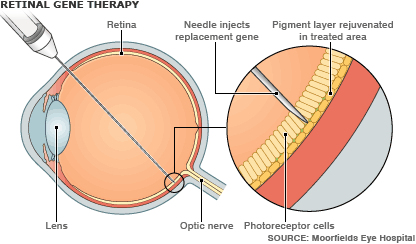|
 |
|||
|---|---|---|---|---|
RESEARCH NEWS |
|||
| Article courtesy of BBC World News | |||
Gene therapy first for poor sight By Pallab Ghosh BBC News, science correspondent |
|||
They operated on Robert Johnson, a UK man born with a sight disorder which deteriorates with age. At present Mr Johnson, who had genes inserted into one eye, can see outlines during the day, but little at night. It will be several months before the researchers know whether their work has been a success. If it is, they believe that it could be used to treat a wide range of inherited sight disorders. How the gene therapy works Mr Johnson's disorder is caused by a faulty gene called RPE65. I keep ranging from extreme nervousness to a bit of excitement
It will be some time before the result is knownHe said: "It's very difficult to say how I'm feeling. I keep ranging from extreme nervousness to a bit of excitement." Lead researcher, Professor Robin Ali, based at the University College London Institute of Ophthalmology, has spent 15 years working with colleagues developing the technique.
|
|||
The surgery required incredible precision. One slip and Mr Johnson's retina would have been torn, and the operation would have failed. However, Robert Maclaren, the assistant surgeon, was pleased with how things went. "We couldn't have asked for a better result. Professor Andrew George, an expert in molecular immunology at Imperial College London, said: "The eye is good for gene therapy because it is a simple organ and it is easy to see what is going on. "There is hope that once gene therapy is developed in the eye, scientists could move on to more complex organs." |
|||
 |
|||
Return to "News and Developments" Main Page |
|||
www.stargardts-au.org |
|||
